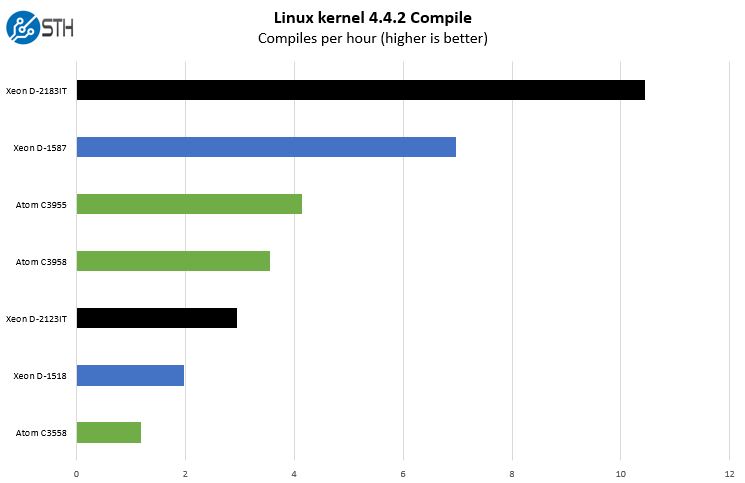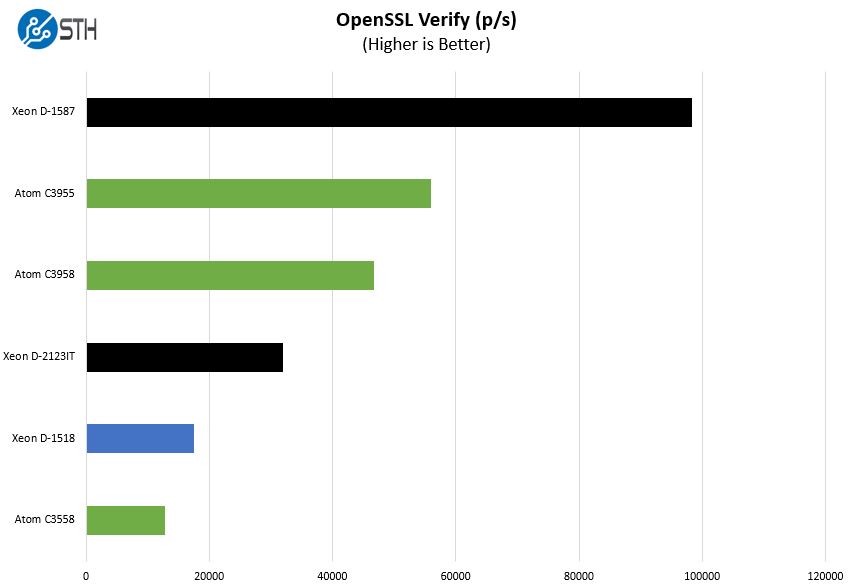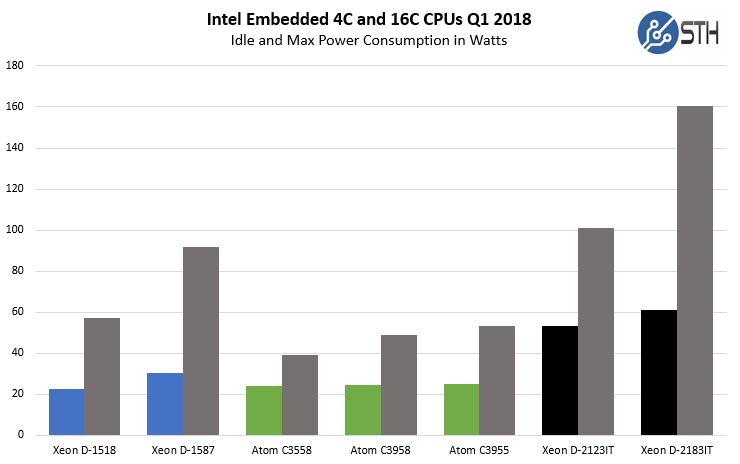Gigabyte MB51-PS0 Performance
The Gigabyte MB51-PS0 utilizes an onboard quad-core, eigh thread Intel Xeon D-2123IT CPU. This is a significant step up from the previous generation Intel Xeon D-1500 series quad-core CPUs and is part of the Skylake series of Intel Xeon architectures. That means it has features such as AVX-512. More importantly, having the same instruction set at the edge allows you to live migrate workloads from a data center to an edge location and back easily. The other implication is that the new architecture is a significant performance improvement.
A benchmark we typically use for this is our Linux kernel compile benchmark. This touches a decent amount of the total system performance factors and is something many Linux admins and developers have the first-hand experience with.

Here the Intel Xeon D-2123IT performs well. Even with the same core count it is about 50% faster than the previous generation Intel Xeon D-1518 with the same core and thread count.
Here is a good example of non-QAT accelerated OpenSSL Verify tests on the same set of CPUs:

OpenSSL is a foundational web element and here the new architecture does not disappoint. It is also important to remember that these are big Xeon Scalable cores, not Atom cores. The per core performance blows the Intel Atom C3000 line away.
Gigabyte MB51-PS0 Power Consumption
In terms of power consumption, we wanted to give a view that shows the idle and maximum observed power consumption of the Gigabyte MB51-PS0 with the onboard Intel Xeon D-2123IT compared to other embedded solutions at 4 core and 16 core levels.

Here the Gigabyte MB51-PS0 is the set of bars represented by the Xeon D-2123IT. Here you can see that the new Xeon D-2100 series is tuned for higher performance but also higher power consumption than previous generation devices.
Final Words
Overall, the Gigabyte MB51-PS0 is in a class to itself. It is a full ATX motherboard which means one can fit two double-width GPUs to the platform. The storage array is an impressive fourteen SATA III headers and both M.2 and U.2 (via Slim SAS) connectors. The Intel Xeon D-2123IT performs extremely well and uses the newest Intel Skylake cores to provide maximum performance. Using the larger form factor allows Gigabyte to maximize the use of the Xeon D-2123IT SoC with features such as providing a full 8 DDR4 DIMM slots to minimize RAM costs. While this is not a compact embedded motherboard, it offers a lot of value through exposing the underlying SoC’s capabilities better than any Xeon D-2123IT motherboard we have seen to date.




I really wish cost was included on these, although all of the Xeon D offerings I’ve seen have been more expensive than I would care to afford.
It’s SO frustrating to keep reviewing these 9+ reviews that don’t come with the context of price. It would probably be a perfect 10 if it were $100. If it were $1M, it would get a much lower review. So…. what does it cost?
https://b2b.gigabyte.com/Server-Motherboard/MB51-PS0-rev-10#ov
GIgabyte’s webpage (above) is describing the D2123IT cpu as being 16 core, while this review describes it as quad core/8 thread….
Which is correct?
Correction: their graphic highlight of features describes it as 16 core, but the specs page lists quad core…probably a typo on their webpage, sorry
For its fairly high performance and impressive storage and networking capability, this Xeon D board gives you fairly high power consumption in a fairly large footprint, with only 2 PCIe slots. I think a comparison against socketed Skylake-SP is warranted. Why would you choose this over (say) a Xeon Silver 4112 + mobo?
Also, thanks for including the Atom 39xx comparisons, showing significantly faster kernel compiles, with half the idle power. Good reminder of the power of parallelism for some workloads. Horses for courses…
James and Kevin – it is somewhat hard given embedded products are generally sold to OEM customers who are buying in quantity. The single boards do not have retail pricing so I have an idea of what retailers will buy them for, but they can list them at whatever price they want which is sometimes higher to reflect their need to discount on deals. On the consumer side, pricing is much easier. On the enterprise/ embedded side, there is a lot more going on.
Mark – the original version was spec’d for the 16 core part but Gigabyte changed that to the 4 core part which should lower pricing by $2K per board.
fmhyr – great question. I would probably use a 4108 or 4110 in the comparison over the Silver 4112. These Xeon D parts are core-for-core faster than their Xeon Silver counterparts.
Patrick, I think you should specify the price disclaimer on every post otherwise this is just going to keep coming up.
Thanks for the review btw, good stuff!
While this is a very interesting review and unit, I am located in the EU area and I cannot find nor pricing or availability anywhere. Is the product available? Do you know any distributors or online retailers that can provide it?
So basically. Very exciting board, no idea about power usage. Compared to the ‘better performing under certain workloads’ Atoms it uses more power, has more capacity for RAM expansion, has more SATA available, has some extra extensions notably AVX512 (Atom has none) and likely is more expensive by thousand(s) of USD
Also still don’t know where to purchase one